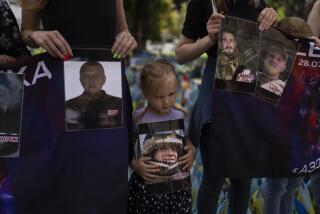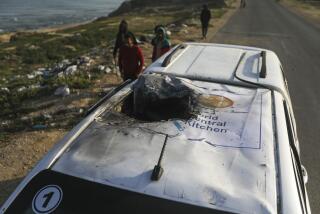‘October Events’ Mysteries: Russians Still Have Doubts : Revolt: The government is the only prober, and its sharpest critics are silenced. Speculation runs rampant.
- Share via
MOSCOW — How many people really died in the shelling and storming of the Russian White House? How did a few thousand pensioners and neo-Communists manage to charge through lines of police in full riot gear? How could the national television center almost be allowed to fall into rebel hands?
The pitched battles in central Moscow between backers and opponents of President Boris N. Yeltsin, now known here as “the October events,” are over. But the mysteries remain.
“Did the White House turn into a mass grave?” the daily Komsomolskaya Pravda asked.
“How many lives did the Oct. 3-5 events cost?” queried the respected Nezavisimaya Gazeta. “Without this truth, there is no truth at all.”
After the 1991 hard-line coup attempt, the Parliament appointed a commission to investigate the three wild days of the putsch.
This time, there is no Parliament to do the appointing; many of the opposition newspapers and parties that would normally be dissecting government mistakes and pushing for answers are banned.
Only a prosecutors’ commission working on criminal cases is officially piecing together the October violence, and mainstream Russian media come out now and then with bits of speculation.
But commission Chairman Vladimir Kazakov pushed aside the big queries making the rounds.
“No one can give you the answers to those questions because no one has them yet,” he said. He refused to be interviewed.
Doubts about the official toll have prompted several investigative articles, despite firm assertions by authorities that 143 people died in the three days of violence.
According to Igor Nadezhdin, spokesman for Moscow’s Main Directorate of Medicine, the toll consists of the 137 victims who ended up in Moscow morgues, plus five soldiers or police officers whose bodies went to special morgues and one journalist who died in a French hospital.
“I’ve heard three numbers--I heard 300 dead, then 500 dead and now 800 dead,” Nadezhdin said. “I absolutely don’t believe in these numbers because, purely technically, dragging out even five corpses, secretly, is very complex.
“And if they were still in there, you’d smell them blocks away,” he said.
But that has not satisfied the Russian press, many of whose members were among the thousands near the White House and the Ostankino television station and witnessed the firefights there.
Nezavisimaya Gazeta found an array of discrepancies between official counts, and it noted that names of people known to have died appeared to be missing from the official lists.
Komsomolskaya Pravda put forth the theory that military aides or police could have secretly smuggled scores of bodies out of the White House to hide the true cost of the attack by pro-Yeltsin forces.
It reported that one witness claimed to have seen about 200 people lying in the courtyard near an outbuilding of the White House, and it quoted Vice President Alexander V. Rutskoi, who led the resistance to Yeltsin, as saying there were hundreds of corpses inside the White House.
Nadezhdin, however, insisted that only about 50 people died in and around the White House and that it is far-fetched to believe that corpses could have been dragged off through tunnels that no one seems to have ever seen.
“For the first time since 1942, the residents of Moscow have been faced with war on the streets,” he said. “We think we know that in times of war, lots of people die. But that’s a mistake. Lots of people are hurt but very few are killed.
“In practice, to kill a person, a person who’s ready for you, is very tough,” he added. “You need a direct shot either to the head or the heart.”
A total of 878 were injured, and only about 40 of those did not need to be hospitalized, he said.
Interior Minister Viktor F. Yerin also noted that although medium-size tanks shelled the White House, they were only trying to frighten its defenders and purposely shot into areas where no people would be hurt or valuable furnishings damaged.
He had a harder time, however, answering another major mystery of the month: how he and other pro-Yeltsin ministers could possibly have slipped up so badly that Ostankino, the nerve center of the national television network, could have come so close to falling into rebel hands.
Lt. Gen. Anatoly Kulikov, commander of the Interior Ministry troops, admitted to reporters that Ostankino’s fate had hinged on a key five minutes, when Interior Ministry troops arrived to reinforce the station’s defenses just before the rebels arrived to attack.
But then, he contended, the station had never been in any real danger--even though Russians had been horrified when broadcasting suddenly stopped on the main channel, suggesting that rebels had triumphed.
Deputy Interior Minister Sergei Stepashin asserted that the attack on the TV station had been a spontaneous move. “I didn’t believe until the last moment that they would . . . resort to such bloody measures,” he told Russian Television.
The Russian publications that go for deep conspiracy theories see such a basic miscalculation as highly unlikely. Instead, some argue that much of the action of the October events was premeditated.
The prestigious Moscow News ran an analysis by an anonymous KGB colonel at a secret institute who is a specialist in fomenting coups and military putsches in Latin America and Indochina under the headline, “Parliament Swallowed the President’s Bait.” He provided several plausible answers for the lingering riddles of those days.
“On Oct. 3, it was hardly an accident that a crowd of 10,000 so easily overran police cordons,” he said, contending that there were clearly enough special forces in Moscow by then--a full 6,000--to quell even a much bigger mob if commanded effectively.
Instead of cracking down, police appeared to ask for trouble by putting barely trained recruits in the front lines against the White House rebels. And there were several buses, with keys waiting in the ignitions, abandoned by police and immediately used by rebels to get from the White House to Ostankino.
“Vehicles with the ignition keys ‘abandoned in panic’ are a trick used by special forces only in banana republics,” he wrote.
In other words, the KGB expert argued, “Yeltsin was not bad at all at setting a trap” for his opponents.
The Russian president knew that whoever spilled the first blood would be condemned, so he provoked--a process known in the KGB as “baiting”--the attack by White House backers, then tried to make it look extremely threatening to justify his all-out counterattack the next day, the colonel said.
“Even though the bait was primitive, they swallowed it hook, line and sinker,” he said.
But now, the question remains whether Yeltsin too fell into a trap. Because, the KGB expert and other commentators say, power in Russia now seems to a frightening extent to lie in the hands of the army and police ministers who appeared to save the day.
“Was it the president’s trap, or a trap for the president?” Moscow News asked.
More to Read
Sign up for Essential California
The most important California stories and recommendations in your inbox every morning.
You may occasionally receive promotional content from the Los Angeles Times.










